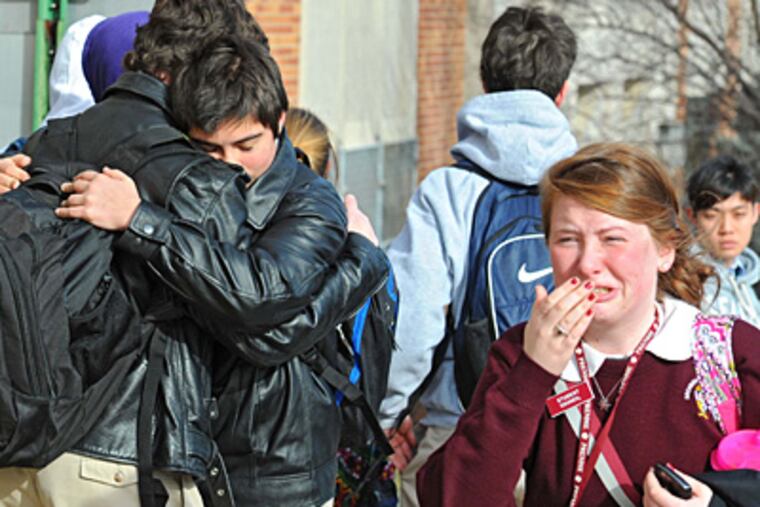At twinned Delco high schools, raw grief at closings
They stood in knots, eyes wet, arms entwined, pouring out tears. The alma mater they cherished like a beloved relative would soon be gone. What next? Where would they go?

They stood in knots, eyes wet, arms entwined, pouring out tears.
The alma mater they cherished like a beloved relative would soon be gone. What next? Where would they go?
In an atmosphere reminiscent of a wake suffused with anger, the students, parents, faculty and staff of Monsignor Bonner and Archbishop Prendergast High Schools held each other Friday as they absorbed the announcement from the Archdiocese of Philadelphia that "Bonner and Prendie," the 60-year-old side-by-side beacons of Catholic education on a rolling hill in Upper Darby, would go dark at the end of the academic year.
As distraught students poured from the building around 1 p.m., parents began arriving to support them.
A scrum of angry boys charged back and forth across the football field, body surfing in a physical expression of their angst. The girls, more restrained and mournful, joined them on the edge of the field.
Parent Amy Reynolds of Drexel Hill, herself a 1993 Prendie graduate, captured the scene for posterity on her cellphone's camera. Her daughter Ali is a senior.
"She gets to graduate," said Reynolds. "But unfortunately, I have an eighth grader, Emily, coming up behind her, and nowhere to send her."
Although the public high school in Upper Darby is just a stone's throw away, Reynolds does not see it as a viable option. "It lacks school spirit," she said of the school, which has had frequent visits from police. She thinks "it's not a safe environment."
Students Paul O'Neill and Deidre Council, both juniors, both 16, stumbled and clung to each other. She is from Darby, he is from Havertown.
"We just burst into tears when the announcement was made," said Council, "but we were together, thank God. . . . We are one family. It's just this bond that we can't break. It's a sisterhood and a brotherhood."
No matter where he ends up for his senior year, said a weepy O'Neill, he intends to wear his Bonner school ring.
The 33-acre hillside campus was originally an estate, with a lavish mansion built in 1850. The church bought the property in 1917 and constructed an orphanage.
In 1953, amid growing demand for Catholic schools, Prendergast High School was born, named for the third archbishop of Philadelphia. Three years later, a second building was erected and dedicated to the memory of the Rev. John J. Bonner, a former diocesan superintendent of schools. Now, boys in khakis, tan suede shoes and signature green hoodies attend Bonner. Girls in gray skirts and wine-red tights are Prendie girls.
The Rev. James Olson, president of the two schools, maintained his composure as he briefed reporters, even as his voice thickened with emotion.
He said the schools would do everything they could "to make sure the kids know what their options are for next year."
"We will work with some of the other schools that are nearby. Any school that any kid expresses an interest in, we will work with. We will try to make sure that we find the absolute best fit for every kid."
School counselors, academic advisers and advisers from the other schools would be called on to help.
The students, he said, already have fretted about "the littlest details. Things you don't think of sometimes [are] very important to the kids. 'Will I wear my same uniform, or will I have to buy a new one?' "
He said he did not yet know how many people will lose jobs.
Prendie and Bonner combined have 48 nonteaching staff and 45 teachers. Olson said he hoped the system would be able to find work for the nonfaculty staff. He said he thought teachers would probably have a chance to move with the students to the other schools.
Someone asked where to "lay the blame" for the closings, which affect four high schools, with Bonner and Prendie counted as one.
"The blame lays not with any one individual, certainly not with anyone here at the school," Olson said. "Sometimes things are a function of a shift in demographics. People move. There are other schools that are remaining open because of those same factors. We have to provide the maximum for every student and we might not be able to do that if we spread out our resources and divide it by 17. We can if we divide it by 13."
At an afternoon meeting with parents in the Bonner auditorium, some were not buying that argument.
The first question had an almost biblical ring.
"Is this decision," asked a parent, "written in stone?"
Olson said he thought it was. He acknowledged that there might be some avenues of appeal, but warned against raising false hopes.
He advised parents to give their children "time to grieve, but not too much time," because they need to focus on picking schools for the future.
Among the possibilities is Cardinal O'Hara, a coed school in nearby Springfield. Switching to Bonner's bitter rival would be anathema for their student-athletes, some parents said.
Olson acknowledged their feeling, but said it wouldn't be a problem.
"I teach the kids that beating O'Hara is good for their souls," he teased. "But we are rivals . . . not enemies."